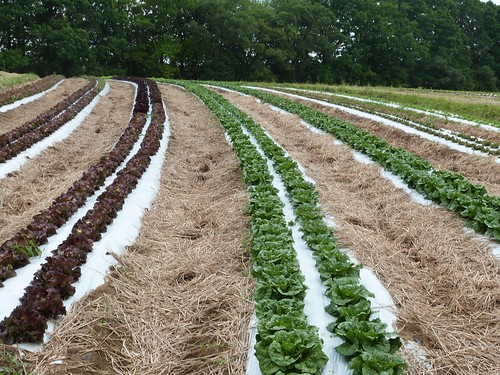
Soils protected from the impact of intense rainstorms by a layer of mulch between rows of lettuce growing at Harvest Valley Farm in Valencia, PA. Photo credit: Franklin Egan, Pennsylvania Association of Sustainable Agriculture (PASA) Director of Educational Programs, a USDA partner
The Pennsylvania Association of Sustainable Agriculture (PASA) sponsored a field day on June 2 to talk about growing vegetables in a changing climate. The discussion focused on climate change, its impacts on the farming system, and strategies to effectively adapt through increasing biodiversity on the farm.
PASA’s Director of Educational Programs, Franklin Egan, provided an overview of climate change trends and projections. Dave King and others who farm 160 acres of vegetables and small fruit all sold within 25 miles of the farm, talked about their challenges and sustainable farming practices. Among them, high tunnel beds have more aphids and pill bugs in the winter, downy mildew appears earlier in the summer, weeds are not any easier to manage especially without degrading soil health, irrigation costs are rising, and deer pressure rises during droughts. Practices being continuously adapted to respond to changing conditions include a highly diversified crop production system, use of beneficial insects, crop rotations, cover cropping, and rye straw mulch.
Several guest speakers contributed their expertise to the program, including John R. Taylor, Ph.D., Assistant Professor of Sustainable Agroecology at Chatham University, Lee Stivers, Penn State Extension Educator in Horticulture and Heather Manzo, Penn State Extension Educator in Ag Entrepreneurship & Community Economic Development. Taylor used an ecological framework to present how different practices increase biodiversity within the larger landscape. Building off of this, Stivers provided an overview of soil health and the win-win role cover crops, crop rotation and crop diversification play in both improving soil quality and removing carbon from the air. Finally the day concluded with a presentation by Manzo on the many resources available from USDA agencies to protect the fiscal sustainability of the farm including crop insurance, NRCS conservation programs, FSA loan programs and many more.
Knowledge exchanged between scientists, educators and farmers facing the reality of climate change is essential to developing practical climate adaptation and greenhouse gas mitigation solutions. PASA’s proactive effort brings resources together to confront the challenges of climate change and keeps its members profitable at producing healthy food while respecting the natural environment. Funding for the Field Day, webinars, a pre-conference track at the recent 25th annual Farming for the Future conference, and a four part series of articles in the association’s newsletter Passages was supported by an EPA Environmental Justice grant (#96335501) for educational programs related to climate change and agriculture, and by the USDA Northeast Climate Hub.
No comments:
Post a Comment
Note: Only a member of this blog may post a comment.